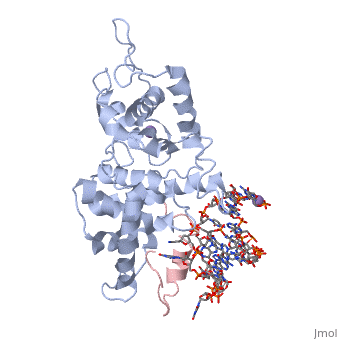2w2h
From Proteopedia
Structural basis of transcription activation by the Cyclin T1-Tat-TAR RNA complex from EIAV
Structural highlights
FunctionCCNT1_HORSE Regulatory subunit of the cyclin-dependent kinase pair (CDK9/cyclin-T1) complex, also called positive transcription elongation factor B (P-TEFb), which facilitates the transition from abortive to productive elongation by phosphorylating the CTD (C-terminal domain) of the large subunit of RNA polymerase II (RNA Pol II). Required to activate the protein kinase activity of CDK9: acts by mediating formation of liquid-liquid phase separation (LLPS) that enhances binding of P-TEFb to the CTD of RNA Pol II.[UniProtKB:O60563] Evolutionary ConservationCheck, as determined by ConSurfDB. You may read the explanation of the method and the full data available from ConSurf. Publication Abstract from PubMedThe replication of many retroviruses is mediated by a transcriptional activator protein, Tat, which activates RNA polymerase II at the level of transcription elongation. Tat interacts with Cyclin T1 of the positive transcription-elongation factor P-TEFb to recruit the transactivation-response TAR RNA, which acts as a promoter element in the transcribed 5' end of the viral long terminal repeat. Here we present the structure of the cyclin box domain of Cyclin T1 in complex with the Tat protein from the equine infectious anemia virus and its corresponding TAR RNA. The basic RNA-recognition motif of Tat adopts a helical structure whose flanking regions interact with a cyclin T-specific loop in the first cyclin box repeat. Together, both proteins coordinate the stem-loop structure of TAR. Our findings show that Tat binds to a surface on Cyclin T1 similar to where recognition motifs from substrate and inhibitor peptides were previously found to interact within Cdk-cyclin pairs. Structural insights into the cyclin T1-Tat-TAR RNA transcription activation complex from EIAV.,Anand K, Schulte A, Vogel-Bachmayr K, Scheffzek K, Geyer M Nat Struct Mol Biol. 2008 Dec;15(12):1287-92. Epub 2008 Nov 23. PMID:19029897[1] From MEDLINE®/PubMed®, a database of the U.S. National Library of Medicine. See AlsoReferences
| ||||||||||||||||||||


